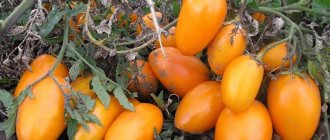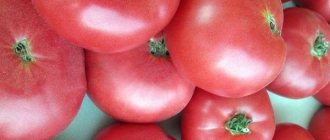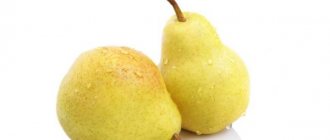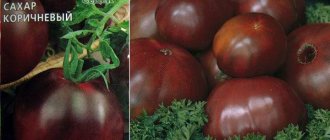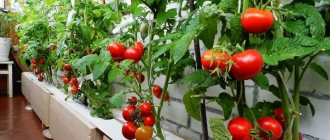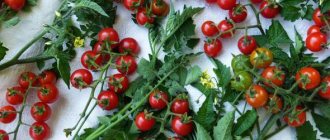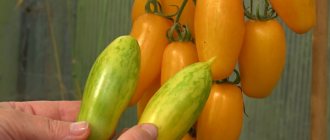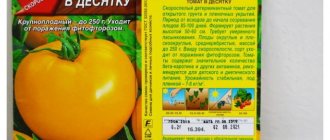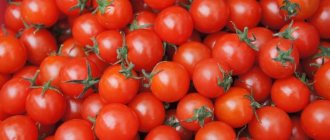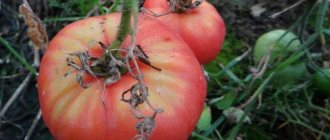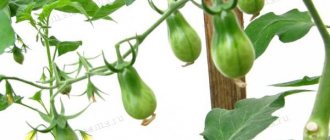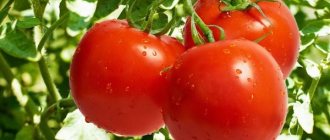The best determinate varieties of tomatoes for greenhouses in Siberia
Bourgeois
- mid-early ripening period;
- bush height 80-130 cm (in the southern regions up to 150 cm);
- growing season 100-110 days;
- mass of round red fruits – 200-400 g;
- yield - 3 kg per bush.
The hybrid Bourgeois was bred by Ukrainian breeders and was registered in Russia in 2004. The variety is recommended for cultivation in the southern regions of the country and the middle zone. In the Urals and Siberia, it is often planted in a closed greenhouse or greenhouse.
Tomato Bourgeois
The only drawback is low yield.
- mid-early ripening period;
- growing season – 100-110 days;
- plant height – 60-90 cm;
- fruit weight – 240-280 g;
- the shape of the tomato is round and slightly flattened;
- yield - up to 4 kg per bush.
The high-yielding determinant hybrid Azhur was bred by domestic breeders and was registered in 2007. The culture is recommended for cultivation in the Central regions of Russia, the Krasnodar Territory, and the Astrakhan Region. In regions with a more severe climate (Krasnoyarsk Territory, Chelyabinsk Region) it is planted in a greenhouse.
Tomatoes Openwork
Advantages of the variety: resistance to diseases, pests, lack of moisture. Tomatoes have excellent taste, and the fruits are universally used. There are no significant drawbacks, rather the peculiarities of the culture, which consist in the mandatory formation of bushes and regular application of fertilizers.
Honey cream
- early ripening;
- growing season 90-100 days;
- bush height - 60 cm;
- weight of oval-shaped fruits – 60-70 g;
- yield - 4.2 kg per plant.
The honey cream variety is very tasty, sweet with a slight sourness. The skin of the fruit is dense, which allows the crop to be stored for a long time. The culture has strong immunity and is resistant to fungal and viral infections.
Honey cream
The variety is recommended for cultivation in the middle zone, in the south. In the northern regions of the country, it is better to plant in a greenhouse.
Big Mama
- early ripening;
- growing season 85 days;
- bush height up to 60 cm;
- fruit weight – 200-400 g;
- yield 3-4 kg per plant;
A productive variety, domestic, young, registered in Russia in 2015. It is resistant to mosaic, late blight, and powdery mildew. The tomato was bred for cultivation under film cover. Some gardeners living in the southern regions manage to plant seedlings in open ground.
Advantages of Big Mom: resistance to fruit cracking, good taste, versatility in use. No features or deficiencies were identified.
Big Mama
Gift for a woman
- mid-early ripening period;
- growing season 100-115 days;
- fruits are round in shape, red-pink in color;
- weight of an average-sized tomato – 200-280 g;
- yield - 3.7-5 kg per bush.
The hybrid was bred by Russian breeders for cultivation in open ground and in greenhouses. It is best to plant in the middle zone and in the south of the country.
Advantages of the variety: sweetish taste of the tomato, tender juicy pulp, high yield.
Among the disadvantages, there is a requirement for regular feeding.
Characteristics and description of the Mammoth tomato variety, its yield
Every year there are more and more varieties of tomatoes, and it is especially difficult for beginners to navigate them. The Mammoth tomato is ideal for those farmers who prefer to grow large-fruited tomatoes in their garden.
Description of the Mammoth Giant tomato
Description of the variety is an important stage when choosing planting material
In order not to make a mistake when purchasing, it is important to study all the characteristics of the tomato variety you are interested in.
Currently, a huge number of tomatoes of various shades have been created. The color of the skin and pulp can be red, yellow, pink or even black.
The Mammoth Giant tomato variety is indeterminate; the growth of the main stem is unlimited and can reach up to 2 meters when grown in open ground. It is necessary to tie it to trellises. The leaf shape is the same as most tomatoes. To get maximum yield, the bush needs to be formed into two stems.
The tomato variety Mammoth German Golden is an early ripening tomato. The period from the appearance of the first shoots to harvest is about 95 - 110 days. Under ideal growing conditions, you can harvest up to 10 kg of tomatoes from a bush.
Not susceptible to the development of various diseases, especially viral ones. They tolerate hot, dry weather well.
Description of fruits
The main characteristic of the hybrid is its large fruit; ripe vegetables can weigh up to 1 kg. On average, the weight of the fruit is from 650 to 800 grams. Productivity is high.
Tomatoes of the Mammoth Giant variety are oval-shaped, ribbed. The skin is quite dense, red in color, and may have golden stripes. The pulp is sweet and juicy.
Vegetables are great for eating whole fresh. You can also make delicious juices, lecho and salads from them. They are not suitable for pickling whole, since the vegetables are too large and do not fit in jars.
The main disadvantage is that the fruits are not suitable for long-term storage. After a few weeks, the skin cracks and turns black.
Advantages and disadvantages
Each hybrid has its own advantages and disadvantages.
- This tomato owes positive feedback from many farmers to its abundant yield throughout the growing season;
- Large fruit;
- Drought resistance;
- High taste qualities;
- Universal use in cooking.
The harvested crop cannot be stored for a long time.
In general, no particular deficiencies were found in the plant.
Features of growing in open ground
Despite the fact that Mammoth-Giant tomatoes are distinguished by their unpretentious cultivation, in order to increase the yield it is recommended to follow simple rules of agricultural technology.
Planting material should be sown in the second half of February - the first half of March. After the first pair of cotyledons and a pair of true leaves appear on the seedlings, it must be picked. To do this, it is better to give your preference to peat cups.
1-2 weeks before planting seedlings in open ground, they must be hardened off. Containers with bushes are taken outside every day for 2-3 hours, constantly increasing the time.
The bushes need to be watered once a week; before that, the soil can be loosened and all weeds removed
It is important to monitor the appearance of the plant. If the bushes are weak, very few ovaries are formed, this means that they need mineral and organic fertilizers
Manure, chicken droppings, humus or compost can be used as organic fertilizers. The fertilizer must be diluted with water and watered on the bushes.
Mineral fertilizers are nitrogen, potassium, magnesium or phosphorus. Mineral fertilizing has a good effect on the growth of bushes and the duration of the growing season.
If watering is improper, slugs may appear on tomato bushes. Especially if cabbage grows next door. In order to get rid of them in the beds, you can spread pieces of cloth soaked in beer.
Most insects lay their larvae in the ground. To prevent the appearance of larvae on the bushes, in the fall the soil in the area must be dug up and all weeds removed.
The best productive sweet varieties for the Urals
King of the Early
- growing season 80-90 days;
- fruit weight – 250 g. (the first tomatoes are larger, reaching 500 grams);
- yield - 4-5 kg per bush.
The early king variety was bred by domestic breeders and registered in 2005. Ideal for growing in central Russia, the Urals and northern regions, in particular in the Astrakhan region and Krasnodar region.
Advantages of the Early King: strong immunity, tolerance to fungal infections, good taste, universal use of the fruit. The disadvantages relate mainly to the rules of care: demands on watering and lighting.
King of the Early
Grandma's secret
- growing season 115-125 days;
- bush height over 1.5 m;
- fruit weight – 450-600 g;
- yield - up to 8 kg.
The crop is grown throughout Russia. The Babushkin Secret variety was bred by Siberian breeders and registered in 2007.
Large tomatoes have excellent taste and sweet flesh. The skin of the fruit is dense, so the vegetable retains its freshness for a long time. The plant is tolerant to powdery mildew and fusarium. The only drawback is the tendency to crack.
Pink flamingo
- growing season 90-110 days;
- bush height – 1.5-2 m;
- fruit weight – 200-300 g;
- yield - 5-6 kg per plant.
One of the features of the Pink Flamingo variety is its taste, which is superior in sweetness to many other varieties of tomatoes. The culture grows well in the middle zone and in the south of the country. In regions with harsh climates, growing under cover is recommended.
Samara
- growing season 90-96 days;
- bush height 2-2.2 m, pinching and pinching required;
- fruit weight – 85-100 g;
- yield 3.7-4.3 kg per bush.
The tomato is resistant to cracking, strong immunity resists many diseases and pests, which simplifies the cultivation of the vegetable. The high yield and universal use of fruits have elevated the hybrid to the category of popular among industrialists and summer residents.
Varieties for regions
There are hybrids and varieties that breeders have improved taking into account the characteristic climate characteristics of individual regions. There are varieties designed for areas with dry, hot summers, as well as cultivars for cool climates. Such adapted tomatoes grow well not only in greenhouse conditions, but also in unprotected areas, bringing consistently high yields.
For the middle band
The climate of the region is unstable, since the warm season can be either dry and hot, or cool with a large number of rainy days. For the Moscow region, Orel, Tula, Bryansk, Brest and other areas of the middle zone, tomato cultivars are chosen that tolerate temperature changes well and are resistant to cold snaps. The following varieties are suitable for sowing and further cultivation in this region:
May be interesting Descriptions of the best varieties of tomatoes for individual regions for 2021 How to grow tomato seedlings at home Treatment of blossom end rot on tomatoes
- Champion;
- Spasskaya Tower;
- Snowdrop;
- Fireworks;
- Bull forehead;
- Yusupovsky (Uzbek);
- Bull's Heart;
- Sweet bunch;
- Pink Elephant;
- Big Brother;
- Black Prince;
- Muscovite.
It is better to plant several separate varieties at the same time - a couple of varieties each for the required ripening period. This helps you choose the right tomatoes that will grow best in specific conditions and will bear fruit consistently. In the case of open soil, it is better to choose only those varieties that are resistant to fungal and bacterial diseases characteristic of this crop.
For northern regions
In complicated climatic conditions, only zoned tomato cultivars can grow and bear fruit normally. In cold regions - Siberia, the Far East, the Urals - vegetables are grown only by seedlings and exclusively early ripening varieties that can withstand sudden cold snaps. The following varieties are suitable for the north of Russia:
- Snow fairy tale;
- Abakan pink;
- Sanka;
- Brawler yellow;
- Button;
- Oak;
- Pink fig;
- Coin;
- Demidov;
- Gina;
- Countryman;
- Berdsky large;
- Ballerina;
- Ultra-early;
- Heavyweight of Siberia;
- Lady fingers.
On a note!
Both types of large-fruited tomatoes and small cherry tomatoes are adapted for the northern regions.
For southern regions
In the Krasnodar Territory, Crimea, and also in the Caucasus, the warm season is hot and dry, with few rainy days. To sow and grow strong plants in such weather conditions, it is recommended to choose only heat-resistant tomato cultivars. There are no restrictions on the duration of ripening and fruiting for the south of Russia. The best heat-resistant species that are cultivated in such conditions:
- Titanium;
- Newbie;
- Torch;
- Buffalo;
- Gift;
- Ermak;
- Mikado.
In order for the fruiting of tomatoes to be abundant, the gardener must follow the watering regime, otherwise even heat-resistant varieties of tomatoes may begin to wither and they will not have the strength to form ovaries. But, with the correct selection of a variety or hybrid that is adapted to the climate, and compliance with agricultural technology, any variety will show good and stable yield.
What early varieties of tomatoes should I plant in a greenhouse?
Hurricane
- growing season 93-103 days;
- bush height – 1.9-2.3 m (requires stem shaping and pinching);
- fruit weight – 35-45 g;
- yield - 4 kg per bush.
The advantages of the variety are: early ripening, presentation and good taste, preservation of vegetables during transportation. The fruits are not prone to cracking. The disadvantage is considered to be poor resistance to late blight.
Hurricane tomatoes
Verlioka
- growing season 90-105 days;
- plant height – 1.5 m;
- fruit weight – 80-100 g;
- yield up to 5 kg per bush.
Among the advantages of the variety: ease of care, good immunity, excellent taste of the fruit . However, the plant is demanding on the nutritional value of the soil, and it will also require pinching.
Variety Verlioka
The highest yielding tomatoes for a polycarbonate greenhouse
Pink raisins
- growing season 86-90 days;
- plant height – 1.5 m;
- fruit weight – 60-100 g;
- yield - up to 6 kg per bush.
The culture is resistant to diseases and pests, tomatoes have an excellent taste, and their use is universal.
Tomato has no significant disadvantages.
Mikado pink
- growing season 90-95 days;
- plant growth – 1.7-2.3 m;
- fruit weight – 300-600 g;
- yield - over 5 kg per bush.
The indeterminate variety Mikado is distinguished by its excellent immunity, the taste of tomatoes and their universal use. Disadvantages: tendency to cracking, the need to form a bush and pinching.
Wonder of the earth
- growing season 110-125 days;
- bush growth - 1.5 m;
- fruit weight – 200-250 g;
- yield - over 4.5 per plant.
Read also Setting up an LED lamp with a motion sensor
The miracle of the earth variety is unique in that it was bred by an amateur breeder, so purchasing seeds is problematic. The advantages of the Miracle are: high yield with a long fruiting period, good taste of the fruit and long shelf life, excellent transportability. The tomato is not susceptible to cracking and is resistant to fungal infections.
High-yielding varieties
The list of the most productive varieties for the North-West, according to reviews, may look like this:
- Rumyanets St. Petersburg is a hybrid universal variety that produces up to 13 kg per square meter. m;
- Alsou - up to 500 g per fruit, 4 kg per bush, ripening period - 90 days.
- Demidov - frost-resistant, yields up to 6 kg per bush, pink, incredibly tasty, ripening period - 220 days.
- Parsley gardener . Siberian selection, for open beds, up to 6 kg per bush, there are raspberry and red ones, the fruits are oblong, oval. For universal use.
- Red boom a – up to 30 kg per sq. m, ripens in 95 days, an excellent option for greenhouse cultivation.
- Matroskin - small fruits, 100 g, excellent taste, yield up to 12 kg per bush, come in different colors. The bushes are low and ripen quickly. Due to insufficient advertising, it is little known, but real experts rate it very highly.
When choosing tomato seeds for planting in this large territorial formation, you can even be guided by the names - the Leningrad series (Giant, Early Ripening, Autumn, Chill), Nevsky, Baltic, Hermitage, Palace, Rumyants of Petersburg, Severyanin, Summer Garden.
Tomato is one of the most popular vegetables, rich in vitamins and microelements. The tomato is in great demand due to its versatility: the fruits can be eaten fresh, added to salads, canned, and used to prepare tomato products. Therefore, every gardener strives to place one or more of the most prolific tomato varieties on his plot. Which crops are considered the best for greenhouses with different climatic conditions and dimensions - read below.
Middle and late greenhouse varieties
King of Kings
- growing season 120-135 days;
- plant growth – 1.45-1.85 m;
- tomato weight – 500-1000 g;
- yield per bush – 5.5 kg.
A real giant has good resistance to late blight and rot. The size of the tomato is supported by its excellent taste, which justifies the name.
King of Kings
Bobcat
- growing season 120-130 days;
- plant height – 50-70 cm (sometimes the bush reaches 1.2 m);
- tomato weight – 180-240 g;
- yield over 4 kg.
A hybrid of Dutch origin was registered in Russia in 2008. The tomato is recommended for cultivation in the middle zone. In the northern regions it is grown under cover.
The main advantages of the Bobcat variety: it easily tolerates drought, is resistant to most diseases of nightshade crops, and produces a consistently good harvest. The disadvantage is the ripening period (late ripening), so it cannot be grown throughout the entire territory of the Russian Federation.
Bobcat tomatoes
Rocket
- growing season 115-125 days;
- plant height – 50-70 cm;
- tomato weight – 40-60 g;
- yield - 5-6.5 kg per bush.
The tall variety Raketa was bred by domestic breeders and was registered in 1999. The best harvest results were observed in the southern regions, but thanks to proper agricultural technology, it is possible to harvest a record number of fruits in the middle zone.
The plant is resistant to rot and late blight; its short stature allows the vegetable to be cultivated in open beds, in greenhouses and even on the balcony. The crop is demanding in terms of watering and fertilizing; as a result of poor agricultural practices, tomatoes can crack.
French grape
- medium-late ripening;
- plant height – 1-1.5 m;
- tomato weight – 80-100 g;
- yield - 3.5-4.7 kg per bush.
The advantages of the French grape variety are its unpretentiousness to agricultural technology, the excellent taste of the fruit, and the beautiful appearance of the tomatoes. The harvest is well preserved and transported due to its dense peel. The disadvantage is the late ripening of the fruits; the climate of some regions does not allow ripe tomatoes to be removed from the garden at the end of the season.
Abakansky
- medium-late ripening period (115-125 days);
- plant height – 1.5 m;
- tomato weight – 250-300 g;
- yield per bush – 5 kg.
The appearance and taste of the vegetable are excellent. The culture reacts positively to mineral supplements and is resistant to fungi. The disadvantages are: a weak tomato stem that cannot support large fruits (a garter is required), requirements for watering and lighting.
A large assortment of varieties makes it possible to choose tomato options for summer salads and winter preparations.
Gardeners prefer growing tomatoes in open ground. The best varieties allow you to get the promised harvest without loss. Tomatoes must be strong and disease resistant. It is necessary to collect ripe berries before late blight damage occurs.
Summer residents of the Nizhny Novgorod region should take a responsible approach to the choice of varieties and hybrids. Tomatoes from the south of Russia ripen in open ground. Other regions cannot boast of such a combination of temperature, number of sunny days and precipitation. People have to maneuver.
But choosing the right seeds does not guarantee a good harvest. Tomato is picky about soil structure and acidity. Structuring measures should be carried out.
Gardeners in the Nizhny Novgorod region need to carry out significant preparatory work before planting.
Varieties for greenhouses
Tomato varieties recommended for growing in greenhouses in 2021 have higher yields than those varieties intended for open soil. Indoor tomatoes are more demanding to care for. However, such fruits have higher taste characteristics and a rich aroma. I use them fresh, for salads and canning.
Plum drop F1
A medium-ripe hybrid with good resistance to diseases characteristic of the crop, the bushes are medium-sized, reaching 1-1.5 m. Pear-shaped fruits, weighing 40 g, can be harvested up to 300 pieces per season from one plant, subject to agricultural practices. The skin is yellowish-violet in color, the flesh is juicy and fleshy, sweetish. The yield of the Plum Drop variety reaches 7.5 kg per 1 m² of planting.
Striped flight
It is a medium-sized variety, but the bush needs to be tied up - the shoots may break under the weight of the fruit. Tomatoes are round in shape. The tomato skin is a rich crimson shade, with greenish longitudinal stripes on top of the main color. The taste is sweet and sour, the aroma is pronounced. 20-30 tomatoes are harvested from each bush, the weight of one is 30-40 g. The fruits of the Striped Reis variety are used fresh and for canning.
On a note!
Green fruits of the Striped flight variety can also be used for canning.
Cio-chio-san
A mid-early variety, which is classified as tall; the bushes grow up to 2 m and need a garter. The growing season of the plant is 100-110 days, 50-60 fruits ripen on each cluster, weighing 30-40 g, and up to 3040 kg of crop is harvested from one bush. Tomatoes are elongated pear-shaped, the flesh is sweetish-sour, the aroma is pronounced. The skin is pinkish-raspberry in color.
little fox
A medium-sized variety with a growing season of 100-110 days from the moment of germination. The bushes need to be pinched and tied up, since the stems may lie down under the weight of the crop. Fruits weigh 130 g, ovoid shape. The skin is a rich yellow-orange hue, the flesh is juicy, the taste is sweetish, the aroma is pronounced. The productivity of the Fox variety is high; from 1 m of planting it is possible to harvest up to 9-10 kg of tomatoes.
Dimensionless
A medium-ripe variety, the bushes grow up to 1.5 m, they are prone to lodging due to the large weight of ripening fruits, so the plants need to be tied up. The tomatoes are large, the weight of one can reach up to 1 kg. The fruits are elongated, the skin is deep red. Up to 6-7 kg of tomatoes are removed from the bush. Tomatoes with good transportability, suitable for fresh consumption, processing into juice, paste or sauces, as well as for salads.
Kira F1
A hybrid of the cherry group, the bushes are tall, grow up to 2 m, they need to be tied up. It forms a lot of clusters, each with approximately 15-20 rounded fruits. The skin of tomatoes has a pronounced orange-yellow hue. The pulp is juicy and fleshy, the taste is sweet and sour, and the aroma is rich. Up to 1.5 kg of tomatoes are harvested from each plant, and up to 5-10 kg are obtained from 1 m² of planting. Indicators of keeping quality and transportability of fruits are considered high.
Tornado F1
A mid-early hybrid, which is classified as a determinate plant. The bushes reach 1.5-1.9 m and need a garter. The fruits are round in shape, their weight is 60-80 g. The skin is of a rich red hue, the flesh is sweetish-sour, fleshy, and has a pronounced aroma. The yield of the hybrid reaches 20 kg per 1 m² of planting. Tomatoes have good shelf life; they can be eaten fresh, added to salads or canned. The fruits are also suitable for long-term transportation.
On a note!
The Tornado F1 hybrid has increased resistance (resistance) to cladosporiosis, tobacco mosaic, verticillium and fusarium.
What does a tomato like?
Tomato loves warmth and bright light. Slight shading causes growth to stop. No ovaries are formed, the bush begins to actively grow green mass. The gardener gets grass, not fruits.
Tomato prefers soils that are moisture-permeable, breathable, and light. Clayey ones require sanding, sandy ones require claying. On peat bogs, both components should be applied.
Factors of active growth and fruiting of the plant:
- temperature during germination – 23–25 degrees Celsius;
- growth and development temperature – 25–28 degrees Celsius;
- daylight hours – 16–18 hours;
- optimal air humidity – 60%, soil – 70%;
- soil acidity – 6 pH.
Ideal soils for tomatoes are black soils. On others, the acidity should be changed. To reduce it, add ash and lime.
When the temperature drops to 10 °C, the bush stops growing. Cooling down to 15 ° C - the ovaries crumble. Heat of 30 °C and above leads to sterilization of flower pollen.
Before flowering, the plant actively consumes nitrogen and phosphorus. Then the need for potassium and phosphorus increases.
What is the climate in the Nizhny Novgorod region
The region is located in the temperate zone. The climate is temperate continental. Winter lasts from October to March. Summer begins on June 4th. Warm weather continues until August 15th. 70 days is not enough for the ripening of a heat-loving berry. It is possible to get a harvest from early varieties when grown through seedlings.
In summer, precipitation falls unevenly: in the north-west it is abundant, in the south-east there are frequent summer droughts. The area is blown by winds. Hurricanes occur every 5–10 years. In the summer season there are thunderstorms with hail. Plants need to be covered with non-woven material.
The average temperature in July is +19 °C. On other days it rises above +30 °C, in some areas up to +39 °C. To maintain the ability to bear fruit, tomato plantings must be shaded.
The region is characterized by gray forest, swamp, sod-podzolic, podzolic, and chernozem soils. Fertile black soils make up 1/15 of the occupied territory. The rest have high acidity: 4.6–5 pH. For tomatoes to grow actively, they need to be deoxidized.
What tomatoes to plant
Gardeners in the Nizhny Novgorod region should carefully choose hybrids and varieties of tomatoes. Primary requirements:
- early fruit ripening;
- drought resistance;
- the ability to form ovaries under unfavorable conditions.
It is important to decide on the intended use of the tomatoes. Multi-purpose fruits are suitable for making canned food. They are smaller, more sour, but transportable and shelf-stable.
Salad varieties and hybrids are large, but low-yielding. Their value is their sugary taste and color.
Tomato Bambi F1
Hybrid from breeders of the Poisk company. Agronomists recommend Bambi for growing under temporary shelters and in open ground. The variety is suitable for lovers of cocktail tomatoes.
The plant is determinate. The bushes are low: they stretch up to 50 cm. They do not need staking or shaping.
The berries ripen 110 days after germination. The brush consists of 8 fruits. Intended use: whole canning and fresh consumption.
- spherical shape, flattened at the stalk;
- shiny, smooth;
- uniformly calibrated;
- color – bright red;
- berry weight – 60 g;
- thick skin;
- bright aroma;
- the taste is sweet and sour.
Bambi does not suffer from fusarium or cladosporiosis. The fruits are ripened in a dark pantry. They do not crack during canning. Gardeners note the preservation of marketability during transportation.
Tomato Volgograd early ripening 323
The search offers gardeners an early variety. Ripens very quickly: 95 days from loops to the first fruit. The plant is low: it stretches up to 45 cm. It tends to build up green mass. To prevent fatliquoring, nitrogen should be added in minimal quantities.
Differences and features of tomatoes:
- color – orange-red, glossy;
- weight up to 100 g;
- flattened at the stalk, spherical;
- taste sweet and sour;
- the skin is dense;
- the pulp is juicy;
- smooth to the touch.
Breeders offer universal use of tomatoes. Gardeners note the keeping quality: tomatoes can be stored for up to 3 weeks in the refrigerator. Green tomatoes are ripened without loss.
Tomato Vasilina
Agroholding Poisk created the Vasilina tomato for growing in open ground. Gardeners are encouraged to grow salad tomatoes with raspberry fruits.
- ripens early (from germination to tasting 105 days);
- determinate bush (50 cm tall);
- leaf dark green, large;
- does not require pinching or gartering;
- creates 4 brushes on each stem.
Read also: Strawberry, what kind of dwelling is this?
The berries are bright crimson. Green fruits have a dark spot in the stalk area. It disappears when ripe. Tomatoes grow up to 200 g. The taste is sugary and sour. Manufacturers recommend consuming fresh Vasilina fruits. Gardeners process substandard tomatoes into ketchup and juice.
The fruits retain marketability during transportation. The skin does not crack. Unripe tomatoes are ripened at home.
Tomato Sovereign F1
Agrofirm Poisk is one of the three largest seed producers in Russia. The Sovereign hybrid is grown in problem regions. It represents a series of tomatoes ripening during a short summer. Among tomatoes for open ground in the Nizhny Novgorod region, Sovereign is the leader.
Ripens early (95 days from loops to berries). The bush is determinate (grows up to 90 cm). Due to rapid ripeness, it “escapes” from late blight. Ogorodnikov was pleased with the immunity of the hybrid: it does not suffer from Alternaria, Stolbur, bacteriosis and TMV.
What are the pleasant fruits of the Sovereign:
- dense pulp;
- elongated shape with a sharp tip;
- deep red color;
- 7 seed chambers;
- weighing up to 200 g;
- uniformity of tomatoes;
- thick skin;
- sweet and sour taste.
Gardeners are satisfied with the transportability of the Sovereign. Tomatoes are delicious fresh. They make assorted dishes, juices, and pastes.
Tomato Doll Masha F1
The SeDek company helps grow good tomatoes in open ground in the Nizhny Novgorod region. Breeders offer gardeners the hybrid Doll Masha. The plant has:
- dark green foliage;
- early ripening period (from loops to tomatoes 95 days);
- determinate bush (size 80 cm);
- active foliage growth;
- brushes with 5 berries;
- return of the harvest in one or two waves.
The tomato has excellent immunity: it does not suffer from verticillium. Early ripening “takes away” it from late blight. Compliance with the rules of agricultural technology allows you to get up to 8 kg/m².
Gardeners like the characteristics of tomatoes:
- grow up to 250 g;
- color – bright pink;
- ribbing is weak;
- the pulp is juicy;
- absence of stains in the area of attachment to the hand;
- 6 chambers with small seeds;
- taste – sugary, dessert.
Many appreciated the universal purpose of tomatoes. I was pleased with the transportability and keeping quality (2 weeks in the refrigerator).
The Best Tomato Varieties for the Northwest
Summer residents prefer to grow plants not in greenhouse conditions, but in open ground. It is believed that when insulated, plants grow worse and produce weak and tasteless fruits. But this assertion has no basis. An incorrectly selected variety will be unproductive in any conditions.
Taste, shade, size and beneficial properties are influenced by:
- corrective agricultural technology;
- competent care;
- growing according to the rules;
- fertilizing, fertilizers.
Long-ripening fruits cost a pretty penny. They need careful care and additional treatment against pests and viruses. Therefore, early ripening tomatoes are highly valued in the northwest. Beginners will prefer unpretentious early crops. The shorter the ripening period, the more popular the variety.
Greenhouses and greenhouses
Tall and medium-sized varieties grow in shelters. Preference is given to early ripening plants. Vegetable growers select plants so that tomatoes can develop in greenhouses without additional heating. Popular tomatoes:
- Golden Queen. High-yielding variety. Bright yellow medium fruits. Suitable for consumption and processing. Tall bushes must be shaped and secured to supports for good growth.
- Palace. Grows in film, glass greenhouses. In well-fertilized soil it ripens faster and produces a rich harvest. The fruits are juicy and strong, and are easy to transport.
- Leningradsky early ripening. Needs shaping and trimming of lower leaves. Sweet, non-watery fruits with a pleasant mild aroma. They are resistant to late blight and have a short growing season. Tomatoes ripen in glass, film greenhouses.
- Leningrad Giant. From planting to harvest it takes only 95-96 days. Vegetable growers recommend pinching. The harvest is pink in color with a sweet taste. Used for processing into juices and consumption.
- Igranda. A minimum ripening period is possible only in a heated greenhouse or insulated shelter. All tomatoes turn out round, red, and pleasant to the taste. Plants are not susceptible to pest attacks.
Tomato Palace
For open ground
Open planting implies direct contact of the plant with unfavorable climatic conditions. Gardeners prefer to choose hardy varieties. Heat-loving tomatoes will either not sprout or die at the first low temperatures. Gardeners watch the weather. If frost is predicted at night, the crops are covered with film to prevent their death.
See also Popular varieties of ultra-early ripening tomatoes
According to ripening period
Early ripening varieties include Hermitage. The seeds grow well in open ground and withstand temperature changes. Requires minimal care. Gardeners recommend covering with film at night. Rarely exposed to diseases and pest attacks. Beautiful smooth fruits with a slight sourness.
Leningradsky Chill ripens in a short time. It was bred specifically for northern regions and can withstand low temperatures. The fruits are dense, juicy, and can be stored for a long time. The plant is not tall, but productive. Does not require additional treatment against pests and viruses.
The early plants include Riddle. Gardeners note early ripening on any type of soil. After germination, only 82-83 days pass until ripe fruits. The only downside is the lack of harvest. The bushes are compact and do not require additional tying or fixing. With rapid ripening, the fruits do not lose their rich taste, but cannot be stored for a long time.
short
The Nevsky variety is classified as dwarf tomatoes. They can withstand low temperatures and are rarely susceptible to disease. The bushes are very productive and produce many small fruits. The taste is rich with a slight sourness. Suitable for workpieces. It is easy to care for when grown outdoors or in shelter.
Low-growing and high-yielding Boni MM plants mature in 2.5 months. Despite their miniature size, they are distinguished by their abundant harvest and unpretentiousness. They grow in open ground without additional insulation. Scarlet tomatoes have a dense peel and survive transportation and preservation well.
Standard varieties
Chanterelle belongs to the standard varieties. The tomatoes turn out yellow-orange, slightly elongated. The taste is rich, honey. Suitable for baby food. Forming and tying to supports is recommended. The fruits are enriched with vitamins and microelements, which are not lost during preservation.
Standard varieties include Severyanin tomatoes. Strong bushes feel good in open ground and are not afraid of low temperatures and lack of sunlight. The fruits ripen in clusters and vary in size and shape. The plant is classified as semi-determinate.
Disease resistant
The Cornet variety is planted only under a film in warm soil. Sweet and bright taste, thin but durable skin. Does not withstand long-term storage. Does not require careful care or grooming.
Compact Yamal tomatoes are characterized by early ripening. Suitable for growing without insulation, without warming the ground. They have average productivity. The fruits have a rich sweet taste with sourness. Plants tolerate climatic conditions, are not attacked by pests, and are resistant to viruses and diseases.
The best varieties for winter preparations
The small fruits of Dachnik tomatoes are distinguished by dense skin that does not crack during processing. Does not crack during long-term storage, is not susceptible to diseases and pests. Compact bushes do not require careful care. The Dachnik variety is ideal for canning and winter preparations.
Petersburg blush is also well suited for winter preparations. Dense juicy fruits of a red-pink hue. The variety is distinguished by early ripening and rapid ripening of fruits even in open ground. Resistant to pests and various diseases.
Large-fruited
Polar Early ripening is distinguished by its large fruit size and ease of care. The fleshy fruits are round in shape and have a pleasant taste. Rarely exposed to diseases and pest attacks. Does not require careful care. Quickly gets used to the conditions. Grows in open ground and does not require additional insulation.
Golden Queen is suitable for planting in open ground. The large-fruited plant is resistant to diseases. But unlike the Polar Early, it needs careful care. The bushes grow tall; it is recommended to tie them to high, strong supports. Sugar-sweet fruits do not withstand long-term storage.
The most productive crops
The Far North variety is characterized by high yield. It does not require special care and can withstand the vagaries of the weather. Small oval fruits are suitable for processing and eating. Suitable for long-term storage and winter preparations.
See also Characteristics and description of the Polbig tomato variety
Tomatoes apparently have a high yield. But all fruits come in different sizes and shapes. Each bush forms up to five brushes. Gardeners note that the crop ripens unevenly. Plants need additional feeding. They are planted in open ground and covered with film on cold nights.
Cherry
A sweet dessert taste is inherent in Blosem F1 tomatoes. Refers to early hybrids. Smooth round fruits of 20 grams. They are characterized by high productivity and ease of care. The bushes need tying up. If not properly cared for, they will not yield a bountiful harvest.
Cherry Bonsai are dwarf plants, so there is no need to tie them up. Grown outdoors, needs shelter for cold nights. The average yield is compensated by a rich, bright taste. The fruits are round to round-elongated and red in color.
Black Cherry tomatoes have an unusual dark color. The fruits vary from ten to thirty grams. The growth of bushes is practically unlimited. You will have to tie it up throughout the entire growth. With proper care they grow up to 3.5 meters. It is characterized by productivity, but requires proper care.
All-purpose tomatoes
Severyanin is one of the universal tomatoes. It grows in open ground, glass and film greenhouses. After germination, the fruits will ripen on the ninetieth day. Strong bushes can withstand temperature changes and do not require care. Even with a lack of sunlight, the fruits are bright, with a rich taste and aroma. Develops without additional feeding.
Expert opinion
Stanislav Pavlovich
Gardener with 17 years of experience and our expert
Ask a Question
Advice! Versatility should not affect yield. Such varieties should bear fruit equally in shelter and on open ground.
The Polar Early ripening variety is also considered universal. Does not require additional insulation. This promising variety is easy to care for and can withstand frost. Medium saturated fruits are also formed in poor soil and lack of sunlight. The variety is distinguished by early yield, minimal care and a large number of fruits.
The variety Marshmallow in chocolate is resistant to disease and cold, and is not attacked by pests. The fruits are sweet in taste and have a brown-red color. The dense peel has green stripes. The variety is stable and easy to care for.
Brief conclusions
A short summer is not a death sentence: it is possible to grow tomatoes with this combination of heat, light and humidity. The main thing is to select seeds and comply with all agricultural technology requirements.
70 calendar days of warmth allow gardeners in the Nizhny Novgorod region to get a good harvest of fruits for various purposes.
Adding an article to a new collection
The real battles unfolded during voting for the most productive varieties of tomatoes that our readers grew in their beds. They were evaluated according to various criteria - from frost resistance and keeping quality, to taste and pickling qualities.
Amateur tomato growers from our group on the social network Facebook cast their votes for many varieties that pleased us with their unpretentiousness and productivity in specific conditions. It is simply impossible to mention all varieties of tomatoes in one material. Therefore, we will list only those that, according to practitioners, have become the absolute leaders of the rating. And who, if not tomato growers, can you trust 100%.
Let's start with the lowest lines of the rating and talk about the tomato varieties that received the least number of votes. However, this does not mean that these tomatoes are bad or weak and should not be grown. It’s just not customary to argue about tastes.
Varieties and hybrids of tomatoes for the Nizhny Novgorod region
I buried all the mulch in the ground, and then sowed mustard, which went into the winter. There was so much moisture in the soil that when I pulled out the carrots, the hole under it immediately filled with water. In winter, I again leafed through magazines and thought, how can I grow tomatoes so that they ripen on my bushes? I went shopping again - looking for new varieties, although I already had my own seeds from the productive varieties that I grew: Heavyweight of Siberia, Ilya Muromets, Alyosha Popovich and Cosmonaut Volkov
. In addition to these varieties, I picked up 23 more colorful bags in stores. I chose large, early, low-growing and well-preserved ones.
Following the advice, I decided to treat the seeds before sowing with aloe juice and water (1:2), left them for three hours, then washed them and placed each variety in a separate jar for germination. Three days later they hatched, and I planted them in the soil I bought at the store.
Eagle Heart
A tomato with the proud name Eagle Heart occupies the bottom line of our top. Everyone who grows these giant tomatoes with an elongated tip, shaped like a heart, leaves only positive reviews about it. The weight of the fruit reaches 600-800 g, and sometimes up to 1 kg. One such pink-raspberry fleshy “bug” - and you can feed the whole family with salad! The tomato pulp is sugary, juicy and sweet.
The variety is determinate, has a medium ripening period - in a greenhouse with nutritious soil the bushes grow up to 170 cm and require pinching and staking. In open ground they may be slightly lower. But their yield sometimes exceeds 10 kg per bush. For the sake of such impressive results, no effort is spared. Moreover, the tomato shows resistance to most diseases, does not lose its shape during transportation and can be stored for up to 3 months.
Tomatoes - the best varieties for open ground
It is difficult to find a vegetable garden where at least one bed is not dedicated to tomatoes. In fact, in the vastness of our country, this vegetable has long enjoyed well-deserved honor and respect, and almost every housewife has her own “cherished” variety of tomatoes. For those who are still looking for the best variety of tomatoes for growing in open ground, the advice from our article will be useful.
The best low-growing varieties of tomatoes for open ground
For novice farmers taking only their first steps in gardening, we recommend starting their acquaintance with tomatoes with low-growing varieties of this plant. Caring for such tomatoes does not require much effort, but at the same time they are capable of producing excellent yields. Low-growing varieties usually grow in the form of a trunk, without requiring tying or pinching, and are distinguished by high cold resistance and the ability to form an ovary at relatively low temperatures. The following low-growing tomato varieties have proven themselves well in open ground:
- "Snowdrop";
- "Polbig";
- "Pink Honey";
- "Danko"
- "Currency";
- "Alsu";
- "Sunny Bunny";
- "Bringer of good luck";
- "Alaska";
- "Ballerina";
- "Heavyweight";
- "Siberian Garden";
- "Siberiada".
The best varieties of tall tomatoes for open ground
Despite the need for additional operations, such as pinching and tying to a trellis, tall varieties of tomatoes have a number of undeniable advantages. They are simply irreplaceable in conditions of limited space, as they allow you to get a significant harvest even from one bush. In addition, tall tomatoes receive more sunlight and air, making them less susceptible to fungal diseases. And most importantly, they have a longer fruiting period. In open ground, the following varieties of tall tomatoes show excellent results:
- "Watermelon";
- "Commissioner";
- "Scarlet Mustang";
- "Verlioka";
- "Black Prince";
- "Tiger";
- "Peach";
- "Alexander".
The best varieties of cherry tomatoes for open ground
Cherry tomatoes, which recently celebrated their fortieth anniversary since their introduction, have many fans around the world. The small and very sweet fruits of these tomatoes are tasty both fresh and pickled. In addition, many gardeners are attracted by their method of fruiting - not singly, but in clusters. The best cherry varieties for growing in open ground are the following:
- "Beads";
- "Noon";
- "Rose Quartz";
- "Amber";
- "Orange grapes";
- "White currant";
- "Golden Rain";
- "Crazy Cherry";
- "Chocolate pearls"
The best productive tomato varieties for open ground
If you focus on yield when choosing a tomato variety, then the following varieties are the real record holders in this regard:
- "Roma";
- "Alpatieva 905a";
- "King of Siberia";
- "Truffle";
- "Mikado black";
- "The Tsar Bell";
- "Honey Drop";
- "Waterfall";
- "Ilyich F1";
- "Anastasia";
- "Crimson Giant";
- "Black Prince".
And finally, some useful tips on choosing a tomato variety for open ground:
For growing in open beds, it is better to choose early-ripening and ultra-early-ripening varieties, zoned for cultivation in your area. Late and medium ripening varieties may not have time to ripen before the onset of cold weather.
Hybrid varieties are not suitable for growing from your own seeds, as they do not retain varietal characteristics.
In unstable climates, it is worth giving preference to low-growing varieties with increased resistance to frost and disease.
womanadvice.ru
Koenigsberg
A mid-season variety of indeterminate (up to 2 m in height) tomatoes, which confidently took 10th place in our amateur rating. The first fruits usually ripen 110-115 days after sowing the seeds. Even beginners can cope with their cultivation. The variety has been tested and hardened in the harsh conditions of Siberia. Therefore, you can safely plant these tomatoes in open ground. Their productivity indicators are impressive - from 4 to 18 kg per 1 sq.m.
“Konigsberg performed well both in the greenhouse and in the OG.” Yuri Kuzminykh.
The oblong fruits ripen in clusters of 6 pieces, they weigh on average 300 g, under favorable conditions the weight can be 2-3 times higher than the standard declared by the manufacturer. Both the skin and the pulp of tomatoes are dense, which makes them easier to transport. Of course, they are healthier to eat fresh, but they are also very tasty in the form of juice, thick paste or sauce. There are varieties of red and yellow color (Golden Konigsberg).
“Konigsberg is an excellent variety, it bears fruit throughout October, from one bush to 2 buckets. In the greenhouse, of course." Lyudmila Petlyuk.
Characteristics of climatic conditions from the point of view of growing tomatoes
The best varieties and hybrids of tomatoes for the North-West, according to reviews from professional vegetable growers, experienced amateurs and even amateurs, were grown by local breeders, although you should not limit yourself to them only. An excellent selection of tomato varieties is offered by “SeDeK”, “Aelita”, “Gavrish”, “SibSad” and “Sortsemovoshch”. Because the unfavorable weather conditions for growing in Siberia and the Urals, in the Far Eastern District largely coincide with the harsh climatic features of the Leningrad region and areas closer to the north:
- For greenhouse crops, which prevail in industrial farming, there is no need to make any special distinctions between Siberia and the chilly North-West, with its continental climate.
- Experienced gardeners use proven crops when choosing the right one, but in order to form a list of preferences, it is necessary to periodically experiment. You don’t just need to look at the ratings (the best varieties of 2021, 2021, and even 2019), the most productive or the most resistant to cold.
- There are recommendations from the originators, reviews from people who have been growing a certain species for a long time, and distinctions based on a number of requirements.
- For the North-West, two categories are usually recommended - ultra-early, cold-resistant, low-growing - for planting in open ground. They manage to ripen during a short cloudy summer with relatively low temperatures.
- Preference is given to small-sized fruits, because large-fruited ones do not have time to ripen here in the open ground. And even if it turns out with a harvest, it is rarely possible to achieve the dimensions declared by the manufacturer.
- For greenhouses, cultivars that are productive and easy to care for are predominantly chosen. Here you need to focus on the method of greenhouse cultivation: greenhouses, fundamental structures with heating and lighting at an industrial level, polycarbonate greenhouses or simple film shelters.
It is very simple to purchase tomato seeds, focusing only on a colorful picture, but you need to take into account that climatic conditions may not allow you to get the promised presentable harvest. The main selection criterion is suitability for the region, and only then they are selected according to other criteria - suitability for growing in a greenhouse or open ground, yield, type of bush, ripening time. It is worth paying attention to the varieties included in Rosreestr, proposals from “Siberian Garden”, “Sibiriyada”, “Seeds of Altai”.
Abakan pink
On the 9th line - a variety of medium-late ripening (110-120 days from germination), determinate type (height - 70-80 cm). In a greenhouse it can grow up to 140-150 cm. The bush needs to be formed into 1-2 stems and tied up. It will ripen pink, heart-shaped fruits (weighing up to 300 g) with tasty, dense pulp. If cared for correctly, you can harvest tomatoes weighing up to 800g, rivaling in size the popular Ox's Heart.
There are many positive reviews about growing this tomato; no one criticizes it. It can be grown in Siberia, and to protect the bushes from returning spring or late autumn frosts, a light film cover will be enough. This representative of the nightshade family rarely gets sick; you will only have to ward off Colorado potato beetles from immature seedlings. In a word, it won’t cause you much trouble, and will delight you with tomatoes – both in salads in the summer and in preparations for the winter.
“I recommend Abakan pink. Unpretentious and very tasty." Lydia Domnikova-Kazakova.
Green harvest
I want to tell you how I learned to grow tomatoes. We bought the dacha in 2010, with a completely neglected plot of land. In the fall, my husband made a small greenhouse 2.5 x 4.5 m, and I decided to plant tomatoes in it. In winter I bought 5 varieties. I sowed them with dry seeds in different bowls, then planted 6 of them into 5-liter plastic water bottles with the top cut off. I poured 10 cm of earth, then slowly poured it under the elongated seedlings.
Yes, it’s convenient to transport and grow in such a container, but how sick the tomatoes are after that! I planted 20 bushes in a greenhouse, chose the strongest seedlings, but only after 10 days did they begin to grow. The harvest was disappointing, I chose the wrong varieties.
I was pleased only with the Siberian early ripening one, and the rest I collected green, so that I could at least take more in quantity. The neighbors said that everyone picks green tomatoes, since they can’t wait for red ones at all. And they turned out to be right. On August 20, there was an unexpected frost, and we bought thin film for the greenhouse, and by that time it was all torn. All the tomatoes turned black, my harvest amounted to only five buckets.
Subsequently, I found out why the tomatoes bore so poorly. The soil on our site is acidic, I realized this because for two years in a row my beets grew the size of a walnut and horsetail grew a lot. Therefore, in the fall I limed all the beds. That same fall, they made another greenhouse, a larger one - 3x5.5 m. In winter, I bought 11 more varieties.
This time I decided to pick the tomatoes into separate cups. When planted in the ground, the seedlings no longer hurt. I poured water into the hole and lowered the seedlings with a lump of earth directly into the water, then covered them with dry soil. After this, the plants were not watered for a week, but no wilting of the leaves was observed. This time I planted large-fruited varieties, but when choosing bags of seeds, I did not pay attention to the ripening period of the fruits. And it should be!
In mid-August, the bushes were filled with large green tomatoes. The neighbors hurried: “Pack up, what are you waiting for!” And I was waiting for them to turn red. What were you hoping for? I thought that if the film on the greenhouse was intact, then nothing was in danger for my tomatoes. However, it rained every day, and water appeared in the greenhouse between the beds. The tomatoes began to crack from excess moisture, and this happened so quickly that when I, having come to my senses, began to pick the fruits, it was already too late.
Cio-chio-san
The only disadvantage of this indeterminate (sometimes growing up to 2 m) tomato is the need for support and shaping of the bush. The rest is a set of advantages! It is resistant to unfavorable conditions and can grow even in Siberia and the Far East. It bears fruit well not only in the greenhouse, but also in open ground. It is not afraid of the main nightshade diseases.
“In the greenhouse, I am always pleased with the Chio-chio-san variety from Gavrish. Maria Dolzhikova.
In terms of ripening time, the tomato belongs to the mid-early category - 100-120 days pass from the appearance of the first shoots to the start of fruiting. It won’t let you down with the harvest either - although the tomatoes are small (about 30-40 g on average), they ripen up to 50 pcs. on the brushes! So the yield from a bush with proper care is 4 kg and can reach a record 6 kg. And the taste of this tomato is excellent! And in the blanks it looks very presentable.
“Chio-chio-san - sweet, very productive, tall, with up to 50 smooth, thin-skinned sweet tomatoes in a bunch! Universal for both food and preservation.” Tatyana Vznuzdaeva. Tula region
Tall tomatoes for the greenhouse
I definitely plant the listed varieties, but there are also some that I just liked, and I periodically grow them in the greenhouse, but I have not become a fan of them. Of the indeterminates, I like the raceme varieties the most. Again, this is primarily because they look beautiful on the bush. There are only three varieties, and each has a special reason to grow it.
“Intuition F1” is a mid-season hybrid, but I would classify it as a late-season hybrid. Not only does it reach harvest ripeness only by mid-August, but biological maturity also comes quite late. Some specimens of these tomatoes ripen even until the end of October. But, on the other hand, this is convenient because as a result, we have our own fresh tomatoes at home for a very long time. That's why I sow it in February.
Rice. 12. Photo from the end of July, but the fruits have not yet begun to ripen.
But “Intuition F1” is very easy. This hybrid is great for freezing for future use. In winter, I make pizza and frittata with them, as they do not defrost like porridge, but retain their meatiness well when cut.
Rice. 13. The fruits are all smooth and beautiful.
Rice. 14. In this form, I send “Intuition F1” to deep freeze.
“Scarlet Candles” is a cluster variety, mid-season. They don’t have a special taste, but what a shape! Looks impressive in preparations with cucumbers. However, this is why I grow them. It’s nice to admire such a jar later in the winter.
Rice. 15. The length of “Scarlet Candles” is almost like pickling cucumbers.
Rice. 16. “Scarlet candles” look neat, they all have a characteristic “spout”.
“De Barao” is quite late-ripening; I sow it earlier than the bulk of tomatoes. I really like it in preparations, it does not crack and is very tasty, both fresh and pickled.
Rice. 17. "De Barao" is resistant to disease. I always plant it on the north side, tying it above the entrance to the greenhouse, because it is very tall, and the upper tier ripens even in the last ten days of August, despite the first cold nights.
Rice. 18. The fruits are beautiful, all as one.
I have tried a great variety of salad varieties, I still want to find the most delicious one. Of the unusually colored tomatoes, I really like the taste of Malachite Box and Black Prince . Both are tall and require pinching, gartering, and formation into 1-2 stems, but the effort is worth it, the fruits are magnificent. “Black Prince” is dark burgundy when fully ripe.
Rice. 19. “Malachite box” in biological maturity – green.
Rice. 20. All these “Malachite Box” tomatoes are already ripe, although in appearance they seem unripe.
The yellow giants are not inferior in taste, of which the most fleshy and tasty for me are “Yellow Truffle” - of an unusual shape, “Persimmon” - indeed, the pulp is cut like the fruit of the same name, “Golden King” and sweet like a melon, “ Golden Bull" . “Golden Heart” and “Altai Yellow” were less impressive But it should be noted that the shelf life of yellow tomatoes is inferior to red ones. From salad reds, I grew “King of Large”, “Cardinal”, “Canary”, “Bear’s Paw”, “Mazarin”, “Altai Red” . What can I say about them - they are all equal, as if they were selected. It tires them to constantly tug and tie them up. One good thing is that they are large.
Rice. 21. Everyone looks the same on the bush. This is Cardinal.
Rice. 22. “Cardinal” is well kept.
Rice. 24. In the foreground is “Mazarin”. It differs only in shape, in taste - like all other red-fruited ones.
Rice. 25. “Altai Reds”, however, can be praised for their friendly maturation.
Separately, I would like to mention the pink-fruited tomatoes “Miracle of the Earth”. If you are lucky with the summer and it is not very hot, then you can get a good harvest from this variety.
Rice. 26. “Miracle of the Earth” are also tall.
But, if there is not very good ventilation in the greenhouse, then this variety will give a characteristic light yellow border, I don’t like it, and I cut it off before use.
Rice. 27. “Miracle of the Earth” - on the right. They are the same size as the Red Giant on the left.
Separately, it should be said about tall cherry tomatoes, for example, “Chio-chio-san”, “Sweet Cherry F1” and others. Yes, many of them are sweet, they look elegant both in the greenhouse and in pickles, but many of them are thrown away and require careful care. No matter how much I refuse to plant them, I still “break down”, I really want to admire the brushes.
Rice. 28. “Red date” is, of course, delicious.
Rice. 29. “Goldilocks” also tastes good if you resist and don’t eat it half-ripe - and it can be eaten even half-ripe.
Yablonka Russia
Tomatoes with such a reverent name could not help but get into the top - they ripen early - from the time the first shoots appear until the moment when the bushes are completely strewn with small round fruits (weighing about 100 g) and really similar to bulk apples, it takes from 118 to 135 days.
Read also: If you crush a bug, will there be blood?
Many consider this tomato to be problem-free - it is determinate, standard bushes grow low - up to 100 cm; there is no need to shape them and pin them; They are not capricious and feel great and set fruit both in the greenhouse and in the open ground. One bush can simultaneously ripen up to 100 neat tomatoes suitable for canning - the skin will not burst, there is no need to worry. Not a tomato, but just a sight for sore eyes!
Monomakh's hat
6th step of the conditional “pedestal”. These bright red tomatoes will appeal to lovers of large fruits - they weigh from 400 to 900 g. The pulp has a balanced taste thanks to the harmonious ratio of acids and sugar.
The type of fruiting is mid-early (90-110 days pass from the moment the seedlings are planted). The bushes are indeterminate, formed on a trunk. The plant successfully resists diseases, but prefers warmth to cold, so in the northern regions it is better to plant it in a greenhouse. In protected soil conditions, the yield is impressive and reaches 20 kg per 1 sq.m. In the garden, the indicators are also decent - up to 8 kg per bush.
Puzata hut
In terms of the number of votes received, it was not far from Monomakh's Cap. The appearance of these tomatoes fully explains the name. Large (300 g), pear-shaped, ribbed, just like squat gnome houses, these tomatoes ripen early - 105-110 days after planting the seedlings. True, they turn red gradually if there is a lot of heat and sun. They are grown in open ground and under film, where they ripen faster. The fruits are fleshy, taste very sweet and juicy.
The bushes are indeterminate, but even in a greenhouse their height rarely exceeds 170 cm. However, it will not be possible to do without shaping. The stems are thin and need staking, as they can lie down under the weight of the fruit. And the yield of these tomatoes, ripening in clusters of 3-5 pieces, is quite decent - 10-11 kg per bush. They are little susceptible to common cultural diseases, but preventive protective measures have never hurt anyone.
“This year I also want a Puzata hut. Last year a friend had them - just a miracle!” Marina Samoilova.
Golden domes
The collected votes allowed these tomatoes to take 4th place in the rating. They have a lot of good reviews, since the variety has almost no flaws, for which it is recognized and loved by many. It exhibits high resistance to major diseases, and timely applied insecticides will repel harmful insects.
Determinate bushes (height from 90 to 150 cm), medium ripening period (100-116 days). You will still have to form it into 2-3 stems and tie it up, so it won’t be possible without any effort on your part. The yield is very good - up to 13 kg per bush with an average weight of tomatoes of 200-400 g, and if the care is good, they will gain all 800 g! Ripe fruits are bright orange, juicy even in appearance. The pulp is fleshy, very tasty, sweet.
“I love golden domes very much - tasty, productive and beautiful. Excellent variety! Lyubov Chernoguz.
Eagle beak
The bronze “medal” and 3rd place in the ranking goes to Eagle’s Beak, popular among many tomato growers! The variety is mid-season (110-115 days), semi-determinate - the height of strong bushes reaches 120-150 cm. Proper shaping, tying to a trellis and timely pinching will help them develop harmoniously and bear fruit well. Under ideal conditions and with proper agricultural technology, the yield can be up to 8 kg per bush.
“Eagle beak is the best, I have no competition yet, the leader for today.” Olga Nesmeyanova.
The fruits are large, of unusual shape, with an elongated and curved tip, similar to a beak. On average, they weigh 200-400 g, but some grow up to 800 g. The pulp is dense and juicy, with a sweetish taste.
The variety is resistant to the main nightshade diseases - late blight, fusarium and tobacco mosaic virus. Tomatoes tolerate transportation well due to their thick skin and do not crack during canning.
“I really like Eagle Beak. ". Nina Belevtseva.
De Barao
Having pulled away from its “rivals”, the famous De Barao tomato variety takes an honorable 2nd place in the top varieties. The variety is late-ripening (ripening dates vary from 110 to 130 days from the moment of planting the seedlings), indeterminate (2-3 m), sometimes bushes can grow up to 4 m. The main advantages of the variety are its cold resistance, shade tolerance and productivity. These tomatoes grow well and ripen successfully in all regions with a temperate climate, both in greenhouses and in open ground. The plants are so unpretentious that even inexperienced gardeners can care for them.
“The tall De Barao produces stable yields in any weather: in rain, in heat, even in the shade.” Tatiana Trach.
The productivity of De Barao is exceptional - from one bush you can collect from 4 to 10 kg of strong, oblong-shaped fruits weighing about 100 g. It is noteworthy that the plant produces its harvest over a long period of time (up to 3 months). There are varieties with pink, red, yellow and black fruits. Tomatoes store well due to their thick skin and for the same reason are suitable for pickling or pickling.
“The only one who stood in the greenhouse and ripened in October was De Barao. Resistant tin...” Tatiana Gorodetskaya.
